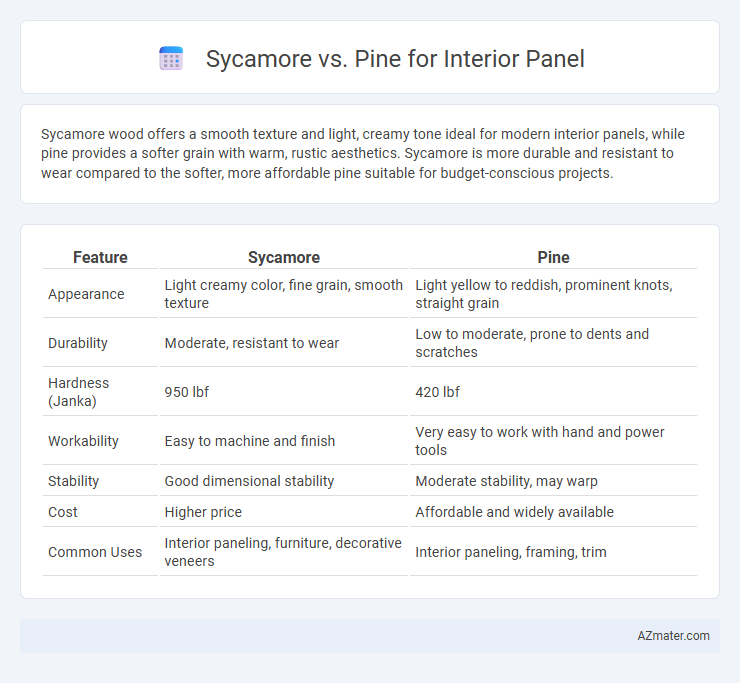Sycamore wood offers a smooth texture and light, creamy tone ideal for modern interior panels, while pine provides a softer grain with warm, rustic aesthetics. Sycamore is more durable and resistant to wear compared to the softer, more affordable pine suitable for budget-conscious projects.
Table of Comparison
| Feature | Sycamore | Pine |
|---|---|---|
| Appearance | Light creamy color, fine grain, smooth texture | Light yellow to reddish, prominent knots, straight grain |
| Durability | Moderate, resistant to wear | Low to moderate, prone to dents and scratches |
| Hardness (Janka) | 950 lbf | 420 lbf |
| Workability | Easy to machine and finish | Very easy to work with hand and power tools |
| Stability | Good dimensional stability | Moderate stability, may warp |
| Cost | Higher price | Affordable and widely available |
| Common Uses | Interior paneling, furniture, decorative veneers | Interior paneling, framing, trim |
Introduction to Sycamore and Pine for Interior Paneling
Sycamore wood offers a smooth texture and light, creamy color that enhances interior paneling with a subtle, elegant appearance ideal for brightening spaces. Pine wood is known for its warm tones, prominent grain patterns, and affordability, making it a popular choice for rustic or traditional interior panel applications. Both woods provide distinct aesthetic qualities and durability, with sycamore favoring modern, clean designs and pine suited for cozy, natural interiors.
Visual Appeal: Grain Patterns and Color Differences
Sycamore offers a distinctive visual appeal with its fine, wavy grain patterns and creamy white to light golden hues, creating a smooth and elegant interior panel surface. Pine displays more pronounced knots and a straight grain with warm, yellowish to reddish-brown tones that add rustic charm and character to indoor spaces. The choice between Sycamore and Pine impacts interior aesthetics significantly, with Sycamore suited for modern, refined designs and Pine favored for cozy, traditional environments.
Durability and Hardness Comparison
Sycamore wood exhibits moderate durability and hardness with a Janka rating around 950, making it suitable for interior paneling in low to medium traffic areas. Pine, particularly Northern White Pine, has a lower Janka hardness of approximately 420, indicating less resistance to dents and wear compared to sycamore. The superior hardness and durability of sycamore provide better long-term performance for interior panels in spaces subject to frequent impact or abrasion.
Workability and Finishing Qualities
Sycamore wood offers excellent workability due to its fine, uniform texture and moderate hardness, making it easy to cut, shape, and sand for interior panels. Its smooth surface readily accepts stains and finishes, resulting in a consistent, attractive appearance that enhances interior aesthetics. Pine, while softer and easier to nail and screw, tends to have knots and resin pockets that can complicate finishing, often requiring more preparation to achieve a smooth, uniform look.
Cost and Availability of Sycamore vs Pine
Sycamore interior panels generally cost more than pine due to their rarity and slower growth rate, making them a premium choice for refined aesthetics. Pine is widely available and more affordable, benefiting from fast growth and abundant supply in many regions. Availability of sycamore is limited compared to pine, which is commonly sourced from sustainable plantations, impacting both price and procurement ease.
Environmental Impact and Sustainability
Sycamore wood, sourced from rapidly growing hardwood trees, offers a renewable option with moderate carbon sequestration and efficient lifecycle sustainability compared to Pine, which is a softwood known for faster growth rates and widespread availability. Pine's lower density contributes to reduced transportation emissions and easier recyclability, while Sycamore's hardwood durability extends panel lifespan, potentially reducing replacement frequency. Both woods require responsible forestry certification such as FSC or PEFC to ensure minimal environmental impact and sustainable harvesting practices for interior panel applications.
Maintenance and Longevity
Sycamore wood offers moderate durability with low maintenance requirements, featuring a smoother grain that resists dirt accumulation and can be easily cleaned with mild soap and water. Pine, while softer and more prone to dents and scratches, requires regular sealing or finishing to protect against moisture and prolong its lifespan in interior panels. Sycamore's natural resistance to wear typically results in longer-lasting panels compared to pine, which may need more frequent refinishing to maintain appearance and integrity.
Acoustic Properties for Interior Spaces
Sycamore offers moderate acoustic absorption, making it suitable for reducing echo and reverberation in interior spaces, especially in environments requiring balanced sound reflection. Pine, with its softer and more porous structure, provides better sound dampening and can effectively absorb noise, improving overall acoustic comfort. Choosing between sycamore and pine depends on specific acoustic goals, with pine favored for enhanced noise reduction and sycamore preferred for controlled sound diffusion.
Best Applications in Interior Design
Sycamore offers a fine grain and light, uniform color, making it ideal for modern and minimalist interior panels where smooth textures and subtle elegance are desired. Pine, with its distinct knots and warm tones, suits rustic or country-style interiors, providing a cozy and natural aesthetic for walls and ceilings. Both woods excel in cabinetry and furniture panels, but sycamore's stability suits high-end finishes, whereas pine is favored for cost-effective, character-rich applications.
Conclusion: Choosing Between Sycamore and Pine for Panels
Sycamore panels feature a smooth, fine grain with a light, creamy color, offering an elegant and contemporary interior finish ideal for modern spaces. Pine panels, characterized by their warm tones and prominent knots, provide a rustic, traditional charm that suits country-style or cozy interiors. Selecting between sycamore and pine depends on the desired aesthetic: sycamore delivers a sleek, refined look, while pine emphasizes natural warmth and character.

Infographic: Sycamore vs Pine for Interior Panel
 azmater.com
azmater.com